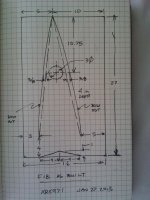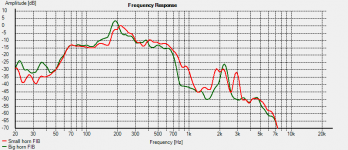Idealy a BiB should be pushed in a corner or at least have some half-space boundary loading, like ceiling and wall.
Positioned out in the open on a wall is considered 2pi [half space] loading:
True Audio Speaker Topics: Spatial Loading
GM
It is probably an air leak at the bottom cap. I will try sealing with plumbers putty before gluing. Everything says it should work, it must be the seal...
Should be monster bass if it works.
I guess I missed something....... how do you know it will have a lot of bass in 1/2 space? BIB requires at least 1/4 space loading AFAIK to protect the driver somewhat below Fs.
GM
I guess I missed something....... how do you know it will have a lot of bass in 1/2 space? BIB requires at least 1/4 space loading AFAIK to protect the driver somewhat below Fs.
GM
Just a little OT question: When you talk about protecting the driver in this way, as you often do, you don't mean the resistive pressure actually stopping the driver from moving?
Rather you're saying that you don't have to EQ it so much to get the same bass, and thereby protecting the driver from over-excursion at peaks?
Am I right?
I think that the resistive pressure is what GM is talking about, although I don't see how a BIB with it's expanding wide open geometry and lack of a throat could ever develop enough resistive back pressure to limit cone excursion, although, if tuned to have resonance at correct frequency near excursion limit it could work.
Update on FIB build in foam core - air leak solved
Ok, good news, it was an air leak on the bottom cap. Once I sealed it, it sounds great! Nice bass and it couples to the wall very nicely. I had to line the flat surface behind the driver with a layer of open cell foam and added more stuffing into the triangle cavity above the driver. This improved the tightness of the bass. Less boomy. Anyhow, it was a good result and I am now proceeding with the second unit build.

It is probably an air leak at the bottom cap. I will try sealing with plumbers putty before gluing. Everything says it should work, it must be the seal...
Should be monster bass if it works.
Ok, good news, it was an air leak on the bottom cap. Once I sealed it, it sounds great! Nice bass and it couples to the wall very nicely. I had to line the flat surface behind the driver with a layer of open cell foam and added more stuffing into the triangle cavity above the driver. This improved the tightness of the bass. Less boomy. Anyhow, it was a good result and I am now proceeding with the second unit build.
I think that the resistive pressure is what GM is talking about, although I don't see how a BIB with it's expanding wide open geometry and lack of a throat could ever develop enough resistive back pressure to limit cone excursion, although, if tuned to have resonance at correct frequency near excursion limit it could work.
My thinking exactly. The resonance effect would be quite weak and only work within a limited window.
Think of a long spring where a wave started at one end has to travel all the way to the end and back again. At some frequencies it could even make the problem worse.
Kec,
The external dimensions are 27 in tall, 16 in wide, 3 in deep. Thickness of material is 3/16 in. The divider is an inverted V (mildly curved to make room for driver) and V comes down to 4 in from bottom so that 8 in x 3 in cross sectional area is preserved. V is laterally offset so that top of (vertex) is 2 in to the side of centerline. Driver is located 10.75 in from top edge. I offset V to reduce phase interference from centrally located driver and to reduce possible phase cancellation issues from two identical mouths combining at top. The curve in the V divider is such that an additional 3/8 in on each side of V is provided to original space next to driver location. Hope that helps.
The external dimensions are 27 in tall, 16 in wide, 3 in deep. Thickness of material is 3/16 in. The divider is an inverted V (mildly curved to make room for driver) and V comes down to 4 in from bottom so that 8 in x 3 in cross sectional area is preserved. V is laterally offset so that top of (vertex) is 2 in to the side of centerline. Driver is located 10.75 in from top edge. I offset V to reduce phase interference from centrally located driver and to reduce possible phase cancellation issues from two identical mouths combining at top. The curve in the V divider is such that an additional 3/8 in on each side of V is provided to original space next to driver location. Hope that helps.
Last edited:
Xr,
Isn't the depth 3"?
Sorry, my blunder. 3 inch depth is correct. I just mounted it on wall and hooked it up to a real amp (45 w/ch ) and this thing rocks! It is very loud and moves a lot of air through the mouth. Great bass that fills room. Very nice
Just a little OT question: When you talk about protecting the driver in this way, as you often do, you don't mean the resistive pressure actually stopping the driver from moving?
Rather you're saying that you don't have to EQ it so much to get the same bass, and thereby protecting the driver from over-excursion at peaks?
Am I right?
What I mean is that the horn's air 'plug' has mass, so it mass loads the driver, lowering its effective Fs, Fp. The extra acoustic efficiency is due to confining the output over a narrower arc same as any horn.
Since the BIB is normally tuned an octave below driver Fs combined with the simple math used to determine its net Vb, its effective Fs/Fp will theoretically be a 1/2 octave lower [~0.707x Fs] in 2pi [1/2] space.
GM
If by 'peak' you mean the pipe's resonant frequency, then yes, if you used the BIB calculator to design it and the driver's measured Fs is fairly close.
It would shift it down some if you really restricted it, but at the expense of bass output higher up, which might be a good thing if it has an overpowering mid-bass unless heavily stuffed.
GM
It would shift it down some if you really restricted it, but at the expense of bass output higher up, which might be a good thing if it has an overpowering mid-bass unless heavily stuffed.
GM
How much stuffing is usually required and where do you put it? I have the section under the driver loosely stuffed and notice a big bump at circa 200 Hz, maybe corresponding to the 16 in wide half-wave mode? I think that is what it is because it is shifted slightly depending on whether I measure the small or big mouth's output. It is huge, 10 to 15 dB above rest of bass platform. I am getting bass down to about 70 Hz so maybe combo of stuffing bottom and adding constrictor at top?
Attachments
Last edited:
Ok. I just don't understand what that has to do with the boundary loading you were talking about in your post. Surely something that is outside the mouth of the horn (or indeed the loading chamber or immediate throat section of the horn) can't have much effect on lovering the Fs of the driver?What I mean is that the horn's air 'plug' has mass, so it mass loads the driver, lowering its effective Fs, Fp. The extra acoustic efficiency is due to confining the output over a narrower arc same as any horn.
Since the BIB is normally tuned an octave below driver Fs combined with the simple math used to determine its net Vb, its effective Fs/Fp will theoretically be a 1/2 octave lower [~0.707x Fs] in 2pi [1/2] space.
GM
- Home
- Loudspeakers
- Full Range
- Terry Cain's BIB -why does it work and does anyone have those Fostex Craft Handbooks?

